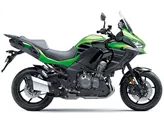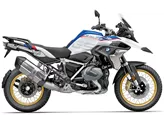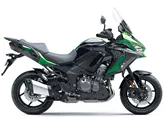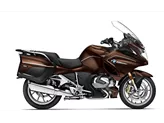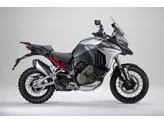BMW R 1200 GS 2015 vs. Kawasaki Versys 1000 2016

BMW R 1200 GS 2015

Kawasaki Versys 1000 2016
Pregled - BMW R 1200 GS 2015 vs Kawasaki Versys 1000 2016
The BMW R 1200 GS 2015 and the Kawasaki Versys 1000 2016 are both popular choices in the enduro motorcycle market. While they have some similarities, they also have distinct differences that set them apart.
Starting with the engine and drive train, the BMW R 1200 GS 2015 is equipped with a Boxer engine, while the Kawasaki Versys 1000 2016 features an in-line four-cylinder engine. The BMW has a larger bore and stroke, resulting in a higher engine power of 125 HP compared to the Versys' 120 HP. However, the Versys has a slightly higher torque of 102 Nm compared to the BMW's 125 Nm. The BMW has a prop shaft transmission, while the Versys uses a chain transmission. The BMW has two cylinders and a displacement of 1170 ccm, while the Versys has four cylinders and a displacement of 1043 ccm.
In terms of suspension, the BMW R 1200 GS 2015 has a strut front suspension with preload adjustment, while the Versys 1000 2016 features an upside-down telescopic fork front suspension with compression, preload, and rebound adjustment. Both bikes have rear suspension with compression, preload, and rebound adjustment.

BMW R 1200 GS 2015
In terms of chassis, the BMW has a steel frame, while the Versys has an aluminum frame. This gives the Versys a more sporty look and potentially better handling.
Both bikes have double disk front brakes, providing good stopping power. The BMW has a 19-inch front tire diameter and a 17-inch rear tire diameter, while the Versys has a 17-inch front and rear tire diameter. The Versys also has a slightly wider rear tire width of 180 mm compared to the BMW's 170 mm.
In terms of dimensions and weights, the BMW has a slightly shorter wheelbase of 1507 mm compared to the Versys' 1520 mm. The seat height of the BMW is 850 mm, while the Versys has a slightly lower seat height of 840 mm. The BMW has a kerb weight (with ABS) of 238 kg, while the Versys weighs slightly more at 250 kg. Both bikes have a fuel tank capacity of around 20-21 liters.
In terms of strengths, the BMW R 1200 GS 2015 is known for its powerful engine, low fuel consumption, comfortable seating position, and its ability to be used off-road. It also has a high reputation in the market. On the other hand, the Kawasaki Versys 1000 2016 has a sporty look, comfortable seating position, powerful and cultivated in-line four-cylinder engine, adjustable windshield, stable chassis, well-controlled braking system, and a clever range of accessories. It also has a comparatively low price.

Kawasaki Versys 1000 2016
However, the BMW R 1200 GS 2015 does have some weaknesses. It has a long and expensive surcharge side, and the Telelever front suspension may take some getting used to. Additionally, the brakes on the BMW are known to be very sharp.
The Kawasaki Versys 1000 2016 also has a couple of weaknesses. The windshield can only be adjusted when the bike is stationary, and the gear indicator costs extra.
In conclusion, both the BMW R 1200 GS 2015 and the Kawasaki Versys 1000 2016 have their own strengths and weaknesses. The BMW offers a powerful engine and off-road capabilities, while the Versys has a sporty look and a range of accessories. Ultimately, the choice between the two will depend on the rider's preferences and priorities.
Tehnične specifikacije BMW R 1200 GS 2015 v primerjavi z Kawasaki Versys 1000 2016
Primerjava prednosti in slabosti
Primerjava prednosti in slabosti
BMW R 1200 GS 2015

A GS is at home almost anywhere - but only to a limited extent on the racetrack. It's a pleasure to feel the power of the partially water-cooled boxer twin cylinder on the exit of the bend - 125 hp only seems much weaker on paper than 150 or even 160 hp on the competition. With 125 Newton metres of torque, the acceleration from the bottom is superb anyway and the GS, at 238 kilos ready to ride, does not carry too much flab despite its bulky appearance. In very tight corners, the low centre of gravity also has a positive effect - the BMW R 1200 GS is very hard to crack! Even the front telelever suspension, which suppresses the front wheel's tendency to sink in when braking, fits perfectly into the overall package on the GS and can only slightly detract from its sporty character.
Kawasaki Versys 1000 2016

Kawasaki Versys 1000 ni povsem nov model, čeprav je oblikovno videti kot tak. Videz je bil spretno prilagojen trenutni agresivni Kawasakijevi liniji z dvema koničastima žarometoma in številnimi robovi spredaj. Po drugi strani pa je bil tehnično previdno nadgrajen - vendar precej smiselno. Dva dodatna konjaka sta moč povečala na 120 KM, ki je zaradi čudovitih lastnosti vrstnega štirivaljnika odlično vozen. Podvozje ustreza športnim zahtevam Kawasakija, ergonomija in udoben položaj sedenja pa omogočata dolga potovanja - kot pri velikem enduru. Z uporabno dodatno opremo, kot so komplet torbic, zgornji kovček, ogrevana držala in dodatni žarometi, Versys 1000 postane resen turni motociklist na dolge razdalje - zaradi razmeroma nizke osnovne cene so ti pripomočki povsem dostopni.
Primerjava povprečnih tržnih cen BMW R 1200 GS vs Kawasaki Versys 1000
There are a few key differences between a BMW R 1200 GS 2015 and a Kawasaki Versys 1000 2016. In terms of price, the actual average price of a BMW R 1200 GS 2015 is about 30% higher. A BMW R 1200 GS 2015 experiences a loss of 440 USD in one year and 1,070 USD in two years of ownership. This is offset by a loss of 1,080 USD and 930 USD for a Kawasaki Versys 1000 2016. Compared to Kawasaki Versys 1000 2016 there are more BMW R 1200 GS 2015 bikes available on the 1000PS.de Marketplace, specifically 47 compared to 7. It takes less time to sell a BMW R 1200 GS with 66 days compared to 88 days for a Kawasaki Versys 1000. Since model year 2005 1000PS.de editors have written 98 reviews for the BMW R 1200 GS and 19 reviews for the Kawasaki Versys 1000 since model year 2012. The first review for the BMW R 1200 GS was published on 1/20/2004 and now has more than 19,100 views. This compares to more than 8,400 views for the first review on Kawasaki Versys 1000 published on 11/7/2011.







